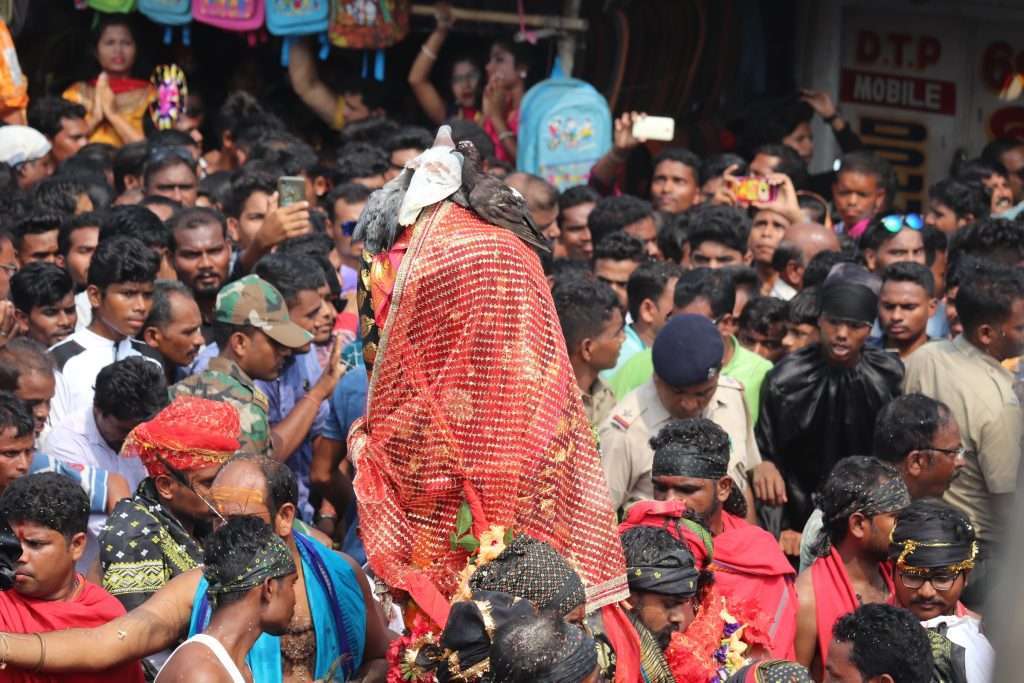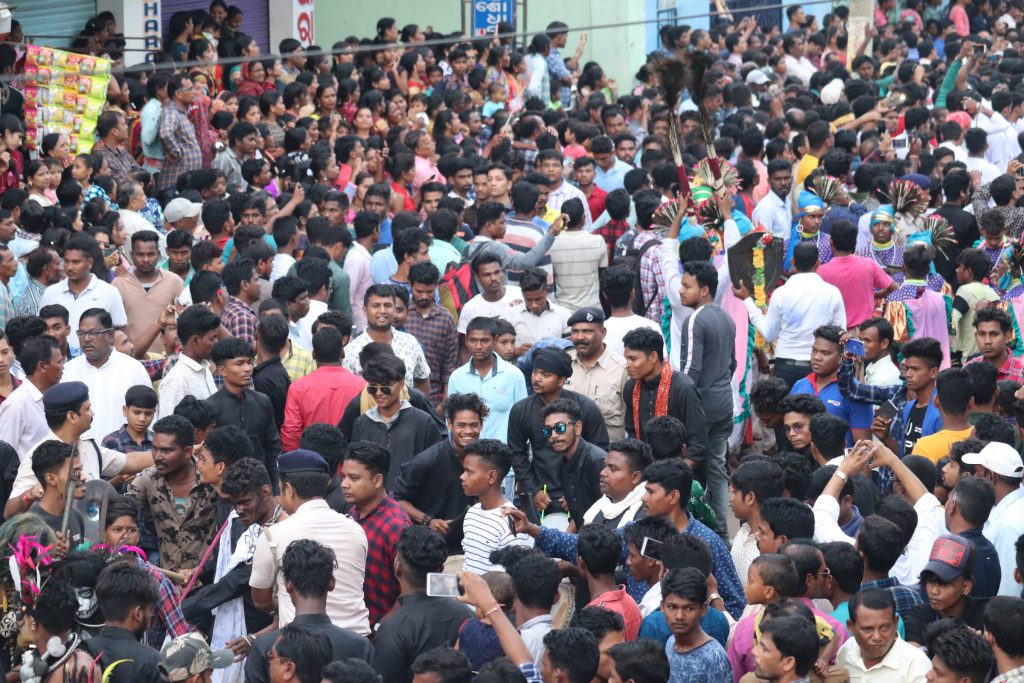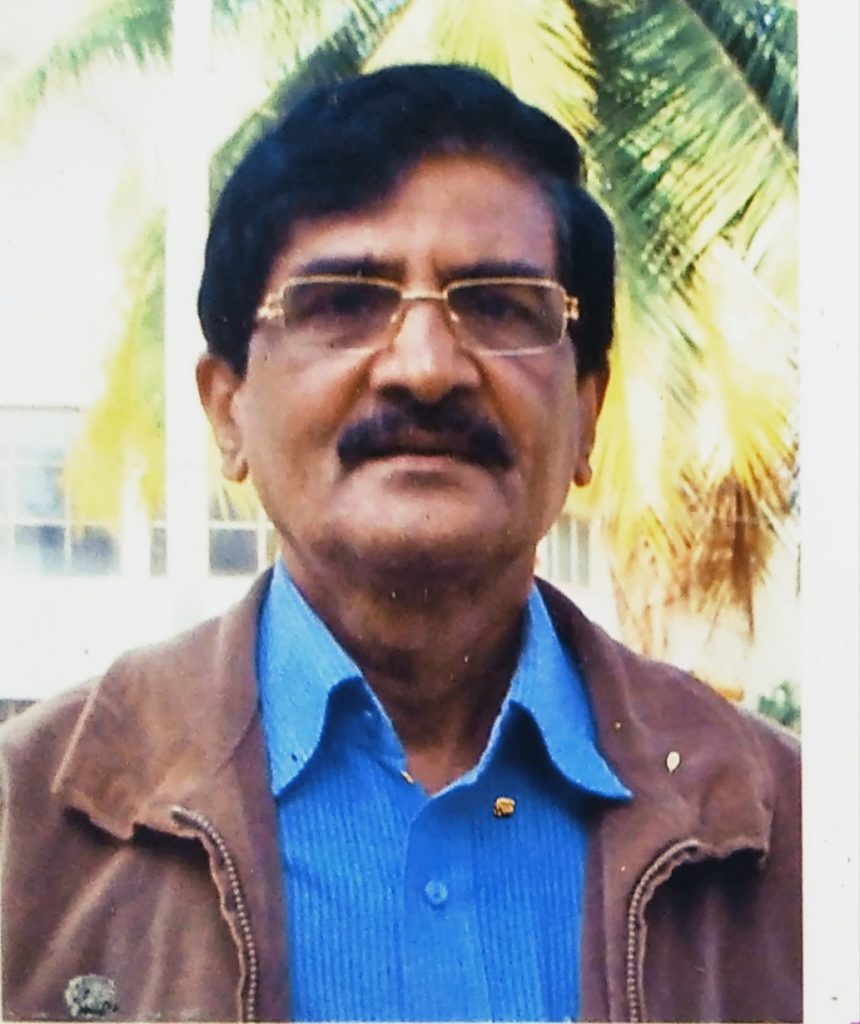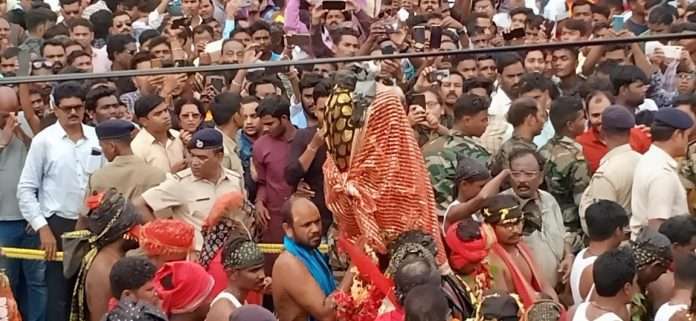Manikeswari deity is a happy blending between vedic and non-vedic culture. There is a resemblance of Stambeswari or pillar worship and Manikeswari so far iconography and rituals are concerned. Ichnographically body of the Manikeswari deity in Bhawanipatna is a cylindrical structure.
Over it a head has been fixed and the body is covered by cloth and ornaments. Like Navakalebara of Jagannath each year in the evening of Mulastami the original head fixed to the cylindrical shaped body is removed to the side and a clay head is placed engraved with gems.
After the Dussehra rituals, the clay head is immersed in Puroswatam Sagar adjacent to the temple and the original head is placed in its original place. The replacement of clay head and its immersion is known as Mundbasa utshav are conducted amidst secret rituals. Similarly, there are several other tribal as well as tantric traditions and rituals which are also observed.
As per legend the 8th king of the Naga dynasty RamachandraDeo along with his widowed mother tookshelter in his maternal uncle’s home at Gadapur after the death of his father in a state of internal disturbance in Kalahandi.
To avoid a situation of anarchy by Kondh chiefs, while returning to Kalahandi he brought Manikeswari with him. He was crowned at Jugsaipatna and there was an alliance between the Royal dynasty and Kondh tribe. Probably at this stage, Kondhs also adopted Manikeswari as Maniksairo, the sister of their deity Dharnipenu. Maniksairo is worshipped along with Dharanipenu in the shape of a stone slab by them.
It is believed that Budharaja (Mahakala Bhairava) the important Parswadevata of Manikeswari is the Budharaja deity of the Gond tribe. There is no image of Budharaja and it is in the shape of a Linga on the mound of earth. The Budharaja temple located on the Northern side entrance of Manikeswari temple is opened only twice. It is opened on Mahasaptami night and closes on Dasami after the Dussehra festival.

It is again opened only on the last Tuesday of Chaitra and remains close till Mahasaptami. After the offerings to Budharaja, the Chatar of Manikeswari leaves for Jenakhal and the Budharaja temple door closes with the conclusion of the Dussehra festival. The Raj Gond chief of Nagjhari Sagada plays a key role during the Nabanna festival of Manikeswari. On the Bhadraba Sukla Dasami morning members from the Raj Gond tribe family of ‘Nagjhari Sagada’ village play the traditional role.
The Gond head man brings new paddy to Manikeswari temple of Bhawanipatna. To thrash the paddy new Kutuni&Paharuni is supplied by a Saura(Sabar) family of Naktiguda and to clean the thrashed rice new Kula is supplied by a Medra family.
Thereafter this rice is cleaned and mixed with Ghee, karpura, grilled Coconut, banana, ginger, gur, cardamom, and pepper. The Raj Gond representative is the first person to offer Nabanna on the doorstep of the Manikeswari temple.
Thereafter, the priest of the temple offered Nabanna in 18 silver pots to the Bije Pratima of Manikeswari, Asta Bharaba, Asta Bhairabi, and other deities. After the performance of the rituals the Raj Gond representative distributes new rice to devotees which they carry home to perform Nuakhai at their home.
However, as the Budharaja temple is opened only during the Dussehra festival Nabanna is offered to Budharaja on Mahanabmi after the ChatarYatra of Maniikeswari. Thereafter the royal family takes Nabanna. This is a unique tradition.
During the Dussehra festival vedic and tantric rituals are strictly followed. During the 16 days period from Mulastami to Mahastami recitations of mantra and homa are conducted as per specification. After Sandhi puja on the night of Mahastami and offerings before Budharaja the Chatra of Manikeswari starts its journey to Jenakhal located in Fasi danger in the western outskirts of Bhawanipatna.
This journey to Jenakhal is conducted secretly and there is restriction and is not open for public participation. It seems it is done to maintain secrecy. Along with the Chatra only the ChatraBahak priest, Bahuka, Dandasena, Mundchina, and the Jena Badya players are accompanied. All of them maintain the sanctity and remain in Upabasa from Mahastami. In the early hours of Mahanavami before sunrise puja and rituals are observed in Jenakhal in a shroud of strict secrecy.
It is believed that the original place where Manikeswari was kept is near Jenakhal and after the construction of the temple in the palace premises she was brought to the temple on Mahanabami. It is also believed that in the remote past human sacrifice was conducted in Jenakhal and so the secrecy during the journey of Chatra to Jenakhal and rituals in Jenakhal is continuing as tradition although human sacrifice is no longer practiced.
After these rituals and offerings, the return journey of Chatra starts towards the temple carried by the ChatraBhaka accompanied by Jenabadya, Ghumura, Nishan, and Ghanta which is known as Chatra Yatra. The chorus creates a thrilling sensation and a sense of awe and wonders to the lakhs of congregated devotees from different parts of the state and neighbouring states.
As a mark of the fulfillment of wishes, devotees make offerings before the Chatra in the route to the temple. The offerings are in the shape of a goat as well as coconut. Many devotees also release doves towards the Chatra on this occasion. Doves flying and many doves covering the distance sitting over the Chatra is an interesting sight.

Lakhabindha ritual of deity Manikeswari is held on the evening of DussehraLakhbindha ground in Bhawanipatna and with this 16 days long Saradiya puja of the deity concludes.On this occasion the Chatra of deity is again brought out to Lakhbindhapadia in the western corner of the town.
After different rituals and puja Lakhabindha or target competition by gun is held. On a long poll in a small earthen pot, the flower of the deity is tied and. participants target the trap tied in the poll.
Manikeswari commands reverence among all sections of people of the locality irrespective of caste and creed. Even today nobody dares to utter lies while swearing in the name of Manikeswari.
(The views expressed are the writer’s own)

Uma Shankar Kar, A senior Journalist, and scholar.
Bhawanipatna , Kalahandi
You can reach him at [email protected]

